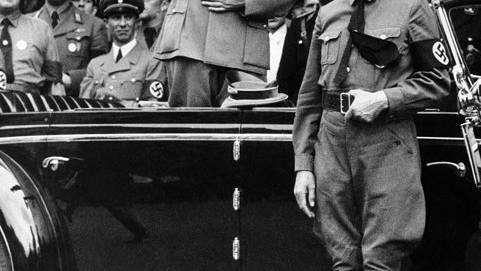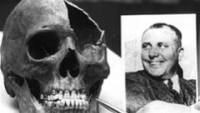Bones of Hitler deputy exhumed, burned
Source: news.yahoo.com
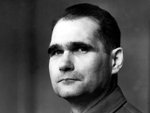 The bones of Adolf Hitler’s deputy Rudolf Hess [left] were exhumed under cover of darkness, burned and secretly scattered at sea after his grave became a shrine for thousands of neo-Nazis, a cemetery official said Thursday.
The bones of Adolf Hitler’s deputy Rudolf Hess [left] were exhumed under cover of darkness, burned and secretly scattered at sea after his grave became a shrine for thousands of neo-Nazis, a cemetery official said Thursday.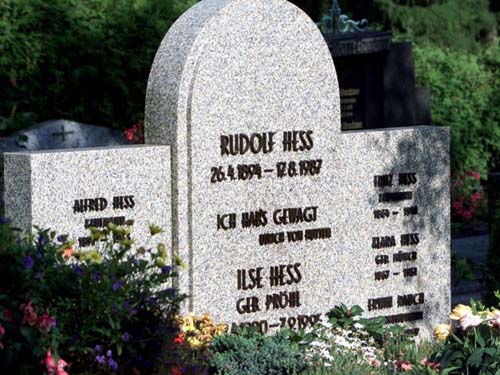
The grave of Adolf Hitler’s deputy Rudolf Hess is seen in Wunsiedel in this August 16, 2000 file picture. The grave of Hess, the last member of Hitler’s cabinet to have died, has been re-opened and his remains have been removed for cremation, German media reported July 21, 2011. His ashes will be buried at sea at a later stage to stop future neo Nazi demonstrations around the anniversary of Hess’ death. REUTERS/Michael Dalder/Files
Workers removed Hess’ remains from his family’s plot with the permission of his relatives, cremated the bones and dispersed them before dawn on Wednesday, said Andreas Fabel, a cemetery administrator in the Bavarian town of Wunsiedel.
Hess was captured in 1941 when he parachuted into Scotland saying he wanted to negotiate peace between Britain and Germany.
The attempt was denounced by Hitler, and Hess later told British authorities that the Nazi leader knew nothing of it. Hess, who spent the rest of his life as a prisoner of the World War II allies and since his death in 1987, became a martyr for the far-right. Neo-Nazis have used the anniversary of his death as an occasion to hold large rallies, with Wunsiedel — near the Czech border — often a focal point.
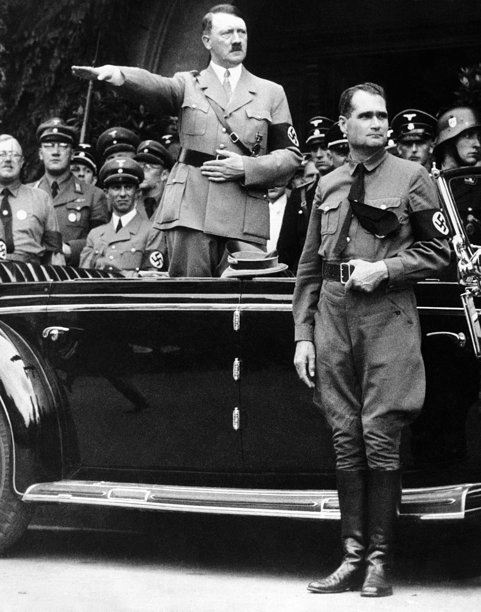
The Dec. 30 1938 file photo shows German Chancellor Adolf Hitler and his personal representative Rudolf Hess, right, during a parade in Berlin, Germany, on Dec. 30, 1938. Minister of Propaganda Dr. Joseph Goebbels can be seen on the left side next to Hitler.
Most such rallies have been banned since stricter laws were implemented in 2005, but the grave continued to attract far-right extremists to the town.
With the lease on the burial plot coming up for renewal in October, Hess’ relatives and Lutheran church authorities in the town decided it was best to remove the remains, Fabel said.
"Both sides were in favor of it," he said.
Charlotte Knobloch, a German Jewish community leader, said the move sends a "clear message."
"I’m happy that the Nazi shadow over Wunsiedel has finally come to an end," she said.
Holocaust survivors also welcomed the move.
"There is now one less place of evil in the world," said Elan Steinberg of the New York-based American Gathering of Holocaust Survivors and their Descendants.
Hess was an early confidant of Hitler’s, and, while Hitler was imprisoned in the 1920s, the Nazi leader dictated much of his infamous manifesto "Mein Kampf," or "My Struggle," to him.
Hess eventually rose to the position of deputy Nazi party leader, but by 1941 his influence with Hitler was waning. His flight to Scotland is widely seen by historians as an attempt to restore his importance.
Instead, Hitler said he was delusional and the British treated him as a prisoner of war.
At the Nuremberg trials after the war, Hess was found innocent of war crimes and crimes against humanity, but sentenced to life imprisonment for crimes against peace and conspiracy to commit crimes against peace.
Hess was the last inmate at Spandau Prison in then-West Berlin when he died on Aug. 17, 1987 at age 93. Allied authorities said he hanged himself with an electrical cord. The prison was demolished shortly afterward and the rubble secretly disposed of.
Article from: news.yahoo.com
